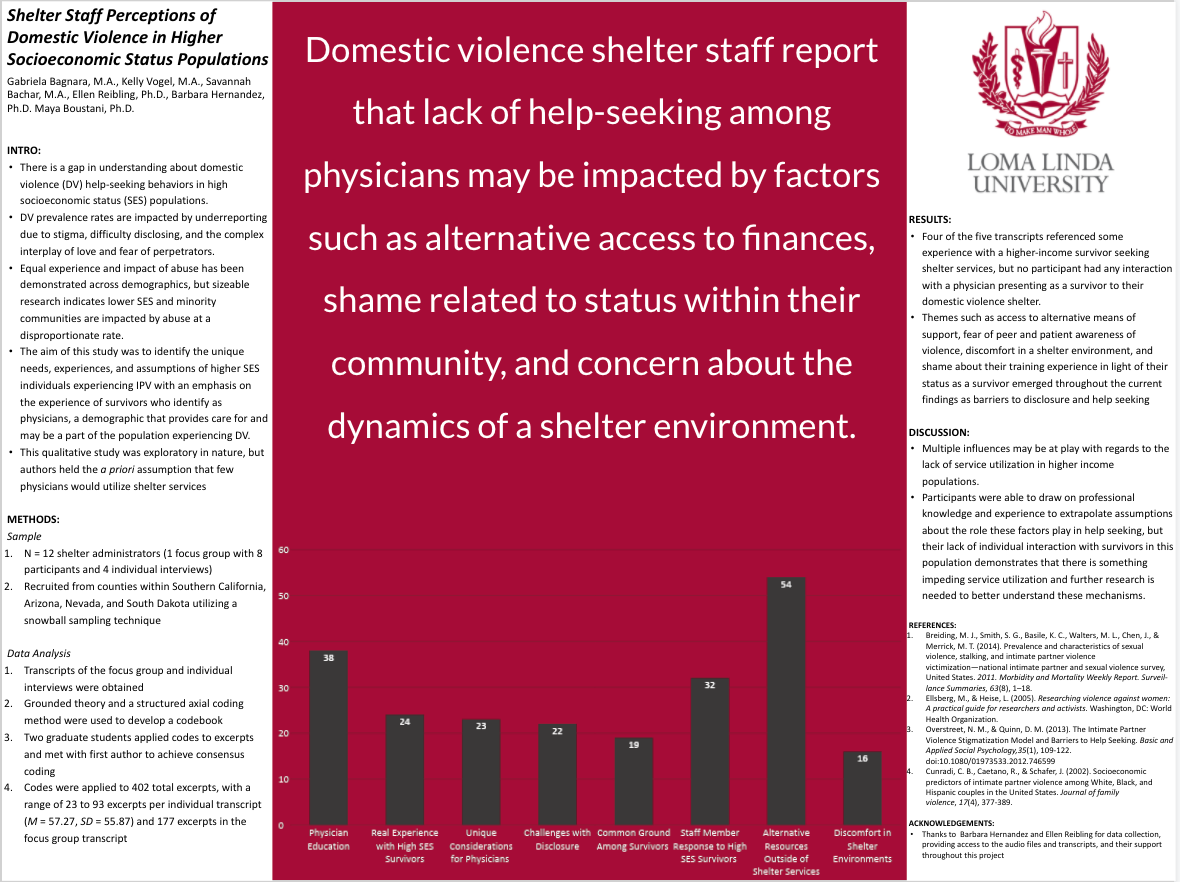Shelter Staff Perceptions of Domestic Violence in Higher Socioeconomic Status Populations

Shelter Staff Perceptions of Domestic Violence in Higher Socioeconomic Status Populations
Gabriela Bagnara, Maya Boustani, Kelly Vogel, Savannah Bachar, Ellen Reibling, Barbara Hernandez
Intimate partner violence (IPV), referred to interchangeably throughout the literature as IPV or domestic violence (DV), is a public health crisis crossing cultural boundaries of gender, socioeconomic status, race, and ethnicity. Current prevalence rates for instances of IPV are understood as estimates, largely impacted by a substantial amount of underreporting due to factors such as stigma, difficulty disclosing, and the complex interplay of love and fear of perpetrators. A large body of research exists about the topic of IPV, but there is little understanding about help-seeking in high socioeconomic status (SES) individuals. Several studies have demonstrated the equal experience and impact of abuse across demographics, but a sizeable amount of research indicates that members of lower SES and minority communities are impacted by abuse at a disproportionate rate. Most of the literature aims to examine these populations’ experiences with IPV, creating a gap in understanding patterns of violence and help-seeking behavior in higher SES individuals. This study aimed to identify the unique needs, experiences, and assumptions of higher SES individuals experiencing IPV. An emphasis was placed on the experience of survivors who identify as physicians, a higher SES demographic that provide care for and may be a part of the population experiencing IPV. While this qualitative study was exploratory in nature, the authors held the a priori assumption that few physicians would utilize shelters due to significant barriers impeding their ability to help-seek.
This study utilized interview and focus group data collected from 12 participants serving as shelter administrators in counties within California, Arizona, Nevada, and South Dakota with first-hand experience providing services to survivors (n = 4 individual interviews and n = 1 focus group). Audio files were transcribed and coded to identify emergent themes. Grounded theory and a structured axial coding method were used to develop a codebook. Subsequently, three of the authors engaged in consensus coding for each of the transcripts. Codes were applied to 402 total excerpts, with a range of 23 to 93 excerpts per individual transcript (M = 57.27, SD = 55.87) and 177 excerpts in the focus group transcript. Emergent themes related to higher-income experience of IPV were developed from codes represented with a frequency of fifty percent or higher. Themes such as access to alternative means of support, fear of peer and patient awareness of violence, discomfort in a shelter environment, and shame about their training experience in light of their status as a survivor emerged throughout the current findings as barriers to disclosure and help seeking in this population. Our findings suggest that there are multiple influences that may be at play with regards to the lack of service utilization in higher income populations. While participants were able to draw on professional knowledge and experience to extrapolate assumptions about the role these factors play in help seeking, their lack of individual interaction with survivors in this population demonstrates that there is something impeding their desire or need to utilize services and further research is needed to better understand these mechanisms.


